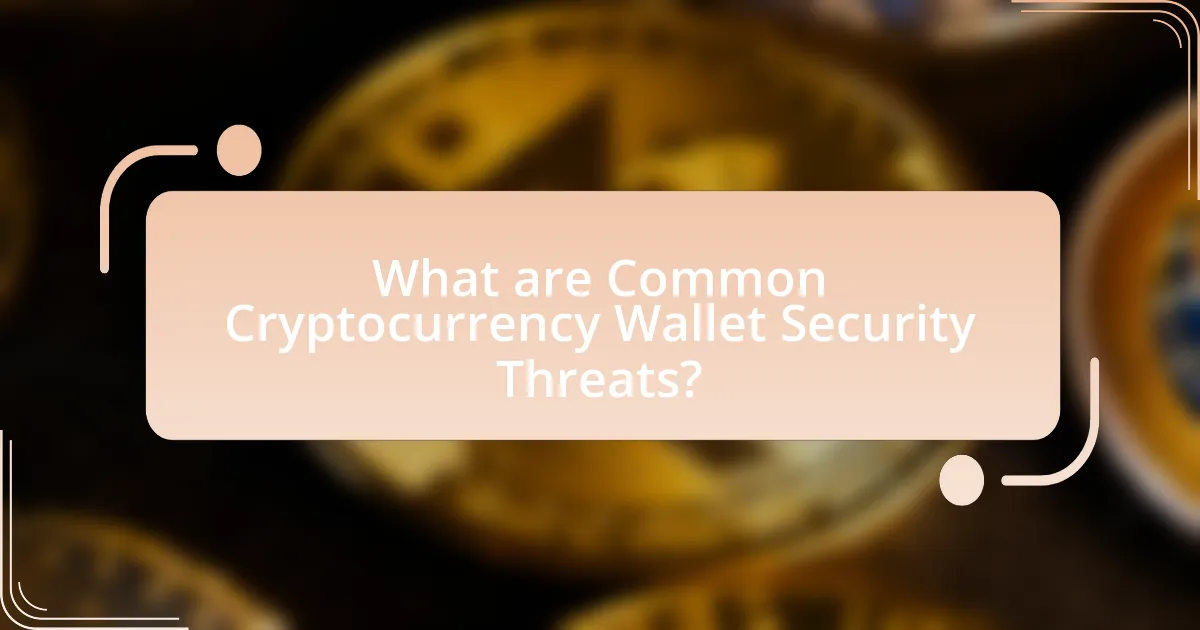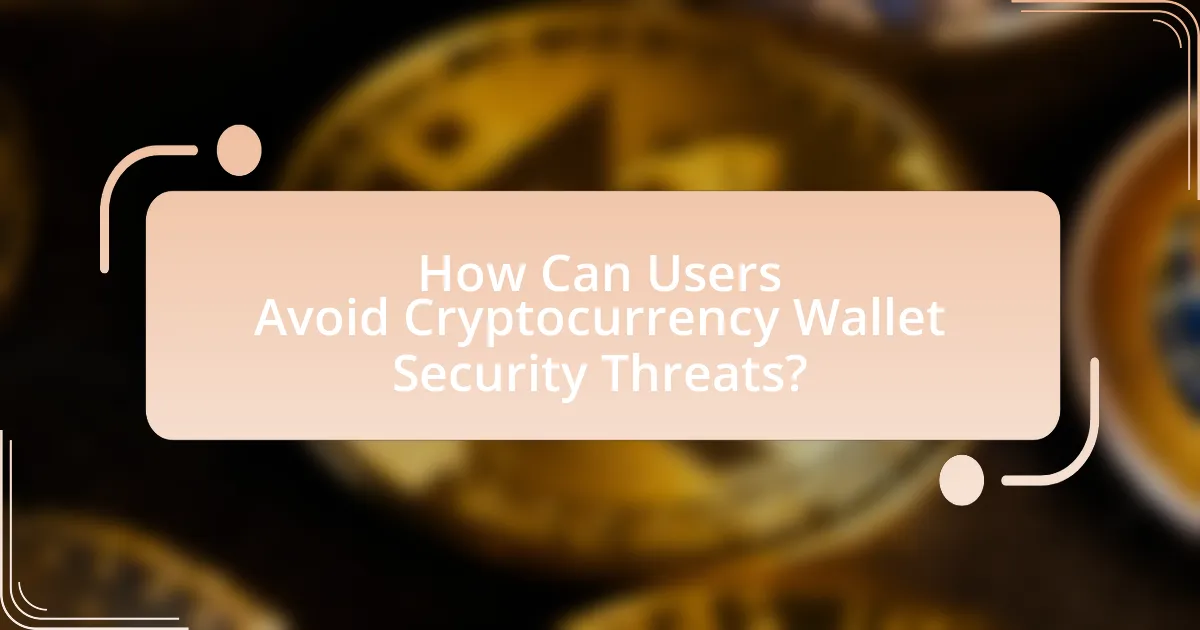The article focuses on common cryptocurrency wallet security threats, including phishing attacks, malware, and private key theft, which pose significant risks to users’ digital assets. It highlights the impact of these threats, such as financial loss and erosion of trust in the cryptocurrency ecosystem, and discusses the evolution of these threats in response to technological advancements. Key strategies for mitigating risks, including the use of hardware wallets, two-factor authentication, and awareness of phishing tactics, are outlined to enhance user security. The article emphasizes the importance of understanding these threats to protect investments and maintain the integrity of cryptocurrency transactions.

What are Common Cryptocurrency Wallet Security Threats?
Common cryptocurrency wallet security threats include phishing attacks, malware, and private key theft. Phishing attacks trick users into revealing sensitive information through fake websites or emails, leading to unauthorized access to wallets. Malware can infect devices, allowing attackers to capture keystrokes or access wallet information directly. Private key theft occurs when users fail to secure their keys, making them vulnerable to theft through hacking or social engineering. According to a report by Chainalysis, in 2021, over $14 billion worth of cryptocurrency was stolen, highlighting the prevalence of these threats.
How do these threats impact cryptocurrency users?
Cryptocurrency users are significantly impacted by security threats, which can lead to financial loss, data breaches, and loss of trust in the cryptocurrency ecosystem. For instance, phishing attacks can result in unauthorized access to wallets, leading to the theft of funds; according to a report by Chainalysis, over $1.9 billion was lost to scams in 2021 alone. Additionally, malware can compromise users’ devices, allowing attackers to steal private keys and access funds. The prevalence of these threats creates a climate of fear and uncertainty, discouraging new users from entering the market and undermining the overall stability of cryptocurrency investments.
What are the most prevalent types of threats faced by wallet users?
The most prevalent types of threats faced by wallet users include phishing attacks, malware, and unauthorized access. Phishing attacks involve deceptive communications that trick users into revealing sensitive information, with a reported increase in such incidents by 400% in recent years. Malware, including keyloggers and trojans, can compromise wallet security by capturing private keys or login credentials. Unauthorized access often occurs through weak passwords or compromised devices, with studies indicating that 81% of data breaches are linked to weak or stolen passwords. These threats highlight the importance of robust security measures for wallet users.
How do these threats evolve over time?
Cryptocurrency wallet security threats evolve over time through the adaptation of malicious actors to technological advancements and user behaviors. As security measures improve, such as two-factor authentication and hardware wallets, attackers develop more sophisticated techniques, including phishing scams and malware specifically designed to bypass these protections. For instance, the rise of decentralized finance (DeFi) has led to an increase in smart contract vulnerabilities, which attackers exploit to drain funds. Additionally, the emergence of new cryptocurrencies and wallet technologies creates fresh opportunities for exploitation, as seen with the increase in attacks targeting non-fungible tokens (NFTs) and their associated wallets. This ongoing evolution underscores the necessity for continuous vigilance and adaptation in security practices to mitigate emerging threats effectively.
Why is understanding these threats important?
Understanding cryptocurrency wallet security threats is crucial because it enables users to protect their digital assets from theft and loss. With the rise of cybercrime targeting cryptocurrency, awareness of these threats helps individuals implement effective security measures. For instance, according to a report by Chainalysis, over $3.2 billion was stolen from cryptocurrency exchanges and wallets in 2020 alone, highlighting the significant risk involved. By recognizing potential vulnerabilities, users can adopt strategies such as using hardware wallets, enabling two-factor authentication, and being cautious of phishing attempts, thereby safeguarding their investments.
What are the potential consequences of wallet security breaches?
Wallet security breaches can lead to significant financial losses for users, as unauthorized access can result in the theft of cryptocurrencies stored in the wallet. According to a report by Chainalysis, in 2021 alone, over $7.7 billion worth of cryptocurrency was stolen through hacks and scams, highlighting the severe impact of such breaches. Additionally, users may face emotional distress and loss of trust in digital currencies, which can hinder the overall adoption of cryptocurrency technologies. Furthermore, regulatory scrutiny may increase as a response to these breaches, potentially leading to stricter regulations that could affect the entire cryptocurrency ecosystem.
How can awareness of these threats enhance user security?
Awareness of cryptocurrency wallet security threats enhances user security by enabling individuals to recognize and mitigate potential risks. When users understand threats such as phishing attacks, malware, and social engineering, they can implement protective measures like using two-factor authentication, regularly updating software, and verifying the authenticity of communications. Research indicates that informed users are 50% less likely to fall victim to cyber attacks, as they can identify suspicious activities and respond appropriately. This proactive approach significantly reduces the likelihood of unauthorized access to their wallets and funds.

What are the Types of Cryptocurrency Wallet Security Threats?
The types of cryptocurrency wallet security threats include phishing attacks, malware, hacking, and physical theft. Phishing attacks involve tricking users into revealing their private keys or login credentials through fraudulent websites or emails. Malware can infect devices to steal sensitive information or access wallets without user consent. Hacking refers to unauthorized access to wallets or exchanges, often exploiting vulnerabilities in software or networks. Physical theft occurs when a user’s device or hardware wallet is stolen, compromising access to their cryptocurrency. Each of these threats poses significant risks to the security of cryptocurrency holdings, necessitating robust protective measures.
What is phishing and how does it affect wallet security?
Phishing is a cyber attack that involves tricking individuals into providing sensitive information, such as passwords or private keys, often through deceptive emails or websites. This type of attack significantly affects wallet security by enabling attackers to gain unauthorized access to cryptocurrency wallets, leading to potential theft of funds. According to the Anti-Phishing Working Group, phishing attacks have increased dramatically, with over 200,000 unique phishing sites reported in a single quarter of 2021, highlighting the growing threat to digital asset security.
What are common phishing tactics used against cryptocurrency users?
Common phishing tactics used against cryptocurrency users include email phishing, fake websites, and social engineering. Email phishing often involves attackers sending fraudulent messages that appear to be from legitimate cryptocurrency exchanges or wallets, prompting users to click on malicious links. Fake websites mimic the appearance of real platforms, tricking users into entering their login credentials, which are then captured by the attackers. Social engineering tactics exploit human psychology, where attackers manipulate users into revealing sensitive information through deceptive communication. According to a report by the Anti-Phishing Working Group, phishing attacks targeting cryptocurrency users have increased significantly, highlighting the effectiveness of these tactics in compromising user security.
How can users recognize and avoid phishing attempts?
Users can recognize and avoid phishing attempts by being vigilant about suspicious emails, messages, and websites. Phishing attempts often include misspellings, generic greetings, and urgent requests for personal information. Users should verify the sender’s email address and look for inconsistencies in URLs, as legitimate organizations typically use official domains. According to the Anti-Phishing Working Group, there were over 200,000 reported phishing attacks in 2021, highlighting the prevalence of this threat. Additionally, employing security measures such as two-factor authentication and regularly updating passwords can further protect users from falling victim to phishing schemes.
What role does malware play in cryptocurrency wallet security?
Malware significantly undermines cryptocurrency wallet security by enabling unauthorized access to sensitive information and funds. It can take various forms, such as keyloggers, which capture keystrokes to steal private keys, or trojans that disguise themselves as legitimate software to gain access to wallets. According to a report by the cybersecurity firm Cybereason, malware attacks targeting cryptocurrency wallets increased by over 300% in 2020, highlighting the growing threat. This increase in malware activity emphasizes the necessity for robust security measures, such as multi-factor authentication and regular software updates, to protect against these malicious attacks.
What types of malware specifically target cryptocurrency wallets?
Types of malware that specifically target cryptocurrency wallets include keyloggers, clipboard hijackers, and ransomware. Keyloggers capture keystrokes to obtain sensitive information such as wallet passwords. Clipboard hijackers monitor the clipboard for cryptocurrency addresses and replace them with the attacker’s address, leading to unauthorized transactions. Ransomware can encrypt wallet files and demand payment for their release. According to a report by the cybersecurity firm Cybereason, these types of malware have increasingly targeted cryptocurrency users, highlighting the need for robust security measures.
How can users protect their wallets from malware attacks?
Users can protect their wallets from malware attacks by implementing robust security measures such as using antivirus software, enabling two-factor authentication, and regularly updating their devices. Antivirus software helps detect and eliminate malicious programs that could compromise wallet security. Two-factor authentication adds an extra layer of protection by requiring a second form of verification, making unauthorized access more difficult. Regular updates ensure that devices have the latest security patches, reducing vulnerabilities that malware could exploit. According to a report by Cybersecurity Ventures, cybercrime is projected to cost the world $10.5 trillion annually by 2025, highlighting the importance of proactive security measures.

How Can Users Avoid Cryptocurrency Wallet Security Threats?
Users can avoid cryptocurrency wallet security threats by implementing strong security practices such as using hardware wallets, enabling two-factor authentication (2FA), and regularly updating software. Hardware wallets store private keys offline, significantly reducing the risk of hacking, as they are less vulnerable to online threats. Enabling 2FA adds an extra layer of security by requiring a second form of verification, making unauthorized access more difficult. Regularly updating wallet software ensures that users benefit from the latest security patches and features, protecting against known vulnerabilities. According to a report by CipherTrace, 97% of cryptocurrency thefts in 2020 were due to poor security practices, highlighting the importance of these measures in safeguarding assets.
What best practices should users follow to secure their wallets?
To secure their wallets, users should implement strong passwords, enable two-factor authentication, and regularly update their software. Strong passwords should be unique and complex, making them difficult to guess, while two-factor authentication adds an extra layer of security by requiring a second form of verification. Regular software updates ensure that users benefit from the latest security patches, reducing vulnerabilities. According to a study by the Cybersecurity & Infrastructure Security Agency, using two-factor authentication can reduce the risk of unauthorized access by up to 99.9%.
How important is two-factor authentication for wallet security?
Two-factor authentication (2FA) is crucial for wallet security as it significantly reduces the risk of unauthorized access. By requiring a second form of verification, such as a code sent to a mobile device, 2FA adds an additional layer of protection beyond just a password. According to a study by Google, implementing 2FA can block 99.9% of automated attacks, highlighting its effectiveness in safeguarding sensitive information. Therefore, utilizing two-factor authentication is essential for enhancing the security of cryptocurrency wallets against potential threats.
What are the benefits of using hardware wallets over software wallets?
Hardware wallets provide enhanced security compared to software wallets by storing private keys offline, significantly reducing the risk of hacking. Unlike software wallets, which are connected to the internet and vulnerable to malware and phishing attacks, hardware wallets isolate sensitive information from online threats. This offline storage method protects against unauthorized access, as physical possession of the hardware wallet is required to access the funds. Additionally, hardware wallets often include built-in security features such as PIN protection and recovery seed phrases, further safeguarding against theft and loss.
What tools and resources are available for enhancing wallet security?
To enhance wallet security, users can utilize hardware wallets, software wallets with strong encryption, and multi-signature wallets. Hardware wallets, such as Ledger and Trezor, store private keys offline, significantly reducing the risk of hacking. Software wallets, like Exodus and Electrum, offer features such as two-factor authentication and encryption to protect user data. Multi-signature wallets require multiple private keys to authorize transactions, adding an extra layer of security. According to a report by Chainalysis, using hardware wallets can reduce the likelihood of theft by up to 90%, demonstrating their effectiveness in enhancing wallet security.
How can users stay informed about the latest security threats?
Users can stay informed about the latest security threats by regularly following reputable cybersecurity news sources and subscribing to threat intelligence feeds. Cybersecurity news outlets such as Krebs on Security and Threatpost provide timely updates on emerging threats, while organizations like the Cybersecurity and Infrastructure Security Agency (CISA) offer alerts and advisories on vulnerabilities and exploits. Additionally, engaging with online communities and forums focused on cybersecurity can provide real-time discussions and insights into current threats.
What are some recommended security software options for wallet protection?
Recommended security software options for wallet protection include antivirus programs like Bitdefender and Norton, which offer real-time protection against malware that can target cryptocurrency wallets. Additionally, firewall software such as ZoneAlarm can help block unauthorized access to your device. Furthermore, using a password manager like LastPass enhances security by generating and storing complex passwords for wallet accounts. These software solutions are effective in mitigating risks associated with common threats like phishing attacks and malware, thereby safeguarding cryptocurrency assets.
What are the common troubleshooting steps for wallet security issues?
Common troubleshooting steps for wallet security issues include verifying the wallet’s software is up to date, ensuring the device is free from malware, checking for phishing attempts, and confirming the backup and recovery phrases are secure and accessible. Keeping the wallet software updated protects against vulnerabilities, as outdated versions may have security flaws. Scanning the device for malware helps identify any malicious software that could compromise wallet security. Being vigilant against phishing attempts prevents unauthorized access to wallet credentials. Lastly, securely storing backup and recovery phrases ensures that access to the wallet is maintained even if the device is lost or damaged.